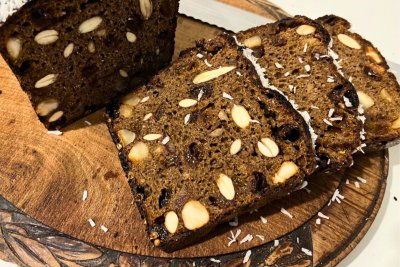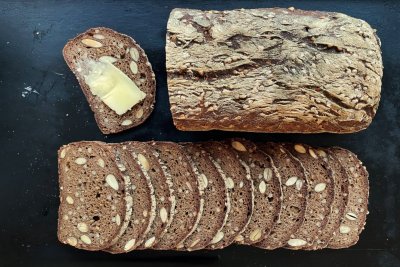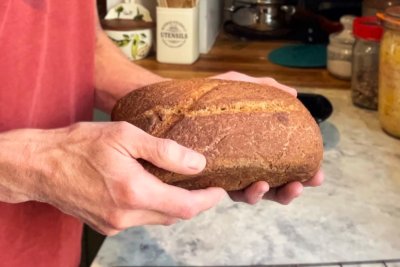Sustain / Real Bread Campaign / Recipes
Boogasse
Hallowe'en hearth bread

Like focaccia, and other flatbreads found across southern and eastern Europe, this loaf – often associated with Provence – takes its name from the Latin word for hearth, where it would once have been baked.
I’ve kept mine plain, but you can throw in a handful of chopped pitted olives, ham, cheese or herbs, in whatever combination you fancy. You can also drizzle yours with plain or herb-infused olive oil just before and/or after they are baked.
Hallowe'en boogasse
Usually, the cuts made through fougasse dough leave it resembling a leaf. A seasonal alternative is creating spooky faces.
Ingredients
Makes: 2 or 3 loaves
The preferment
300g white bread flour
275g water
5g fresh yeast
The dough
350g white bread flour
250g water
2g fresh yeast
50g olive oil
5g table salt
(You can also throw in a handful of chopped pitted olives, ham, cheese or herbs, in whatever combination you fancy.)
Method
Mix the pre-ferment ingredients together, cover and leave at room temperature for 12 hours overnight, or until bubbling vigorously.
Add the dough ingredients to the pre-ferment and knead (“work to an even consistency” is probably a better term, as it’s so sloppy) until you have a smooth, silky, stretchy dough that is very soft but no longer sticky. You may find that this dough is easier to make using a stand mixer with a dough hook.
Cover the dough and give it a series of single folds after 30, 60 and 90 minutes, then leave to rise for a further 2½–3½ hours, or until it’s puffed up and has huge bubbles coming to the surface.
Dust the work surface well with flour and using an oiled dough scraper, turn the dough out carefully, trying not to knock out too many of the bubbles you have (well, the yeast has) worked hard to make. Divide the dough into two or three equal-size pieces, gently rounding each piece into a ball then roll one piece out to an oval about 1.5cm thick.
Using your dough scraper, cut three or four angled slots either side of the middle of the dough to make a leaf-like pattern (see photo) and open these out slightly. Repeat the rolling and cutting with the remaining dough. Cover and leave to prove for 1 hour. Meanwhile, heat the oven to 250°C (230°C fan) / gas mark 9, or as high as it will go, ideally with a baking stone or baking sheet in place.
Using a well-floured peel, slide each fougasse onto a baking stone, then immediately turn the oven down to 220°C (200°C fan) / gas mark 7. Bake for 10–15 minutes until golden, then leave on a rack to cool.
Taken from Slow Dough: Real Bread by Chris Young © Nourish Books 2016. Reproduction prohibited without written agreement of the copyright holder.
See also:
Social sharing
If you make this, please share your photo(s) with the world on social media using #RealBread and other relevant hashtags, linking back to this recipe. Better still if we can see you in the photo, too: #WeAreRealBread!
Please don't forget to tag us, and the recipe's author. You can find us on:
- Instagram: @RealBreadCampaign
- Facebook: @RealBreadCampaign
- Threads: @RealBreadCampaign
- Bluesky: @RealBreadCampaign.Bluesky.Social
Published Wednesday 29 March 2017
Real Bread Campaign: Finding and sharing ways to make bread better for us, our communities and planet.




